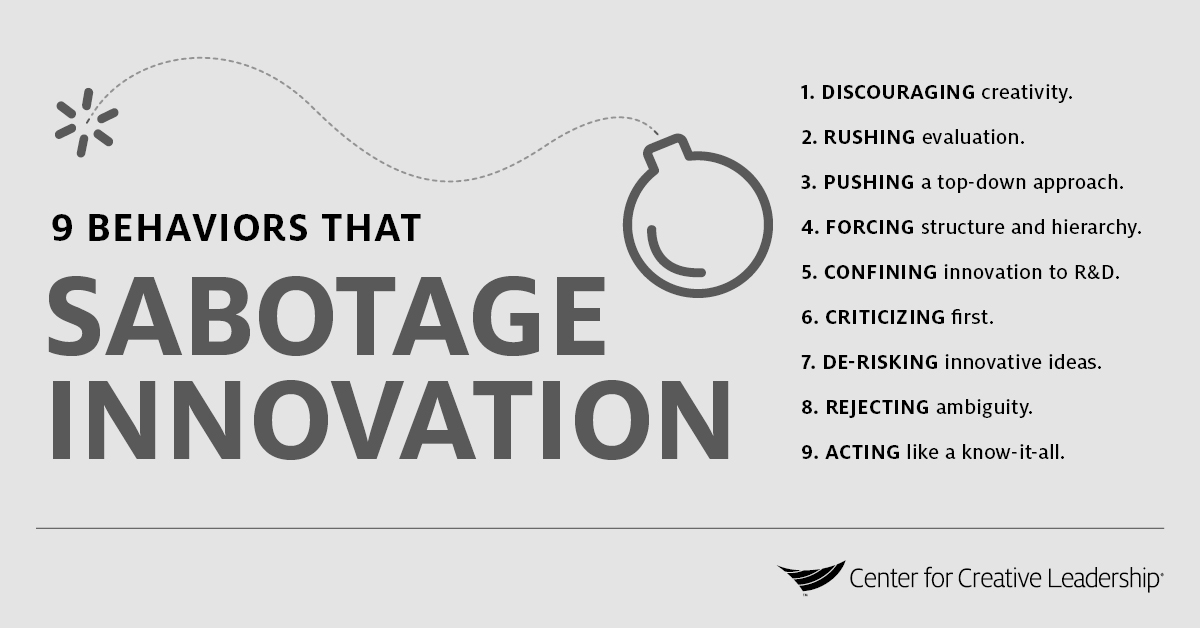How to Encourage Innovation Rather Than Undermine It
Many leaders say they want their organizations to be innovative. They may even say they want “the big idea” — disruptive innovation.
But saying that you want more innovation and creating a leadership culture that actually nurtures innovation are 2 different things.
Far too often, we’ve seen leaders subconsciously sabotage innovation by behaving in ways that kill new ideas. The sabotage isn’t deliberate — they really want to encourage innovative mindsets in their organizations — but they don’t know how to support and encourage innovation, and fail to recognize their counterproductive behaviors are actually undermining their goals.
Be sure you and your organization’s leaders are not falling into this trap.
To Encourage Innovation, Avoid Subconsciously Sabotaging It
Avoid These 9 Mistakes
Want to encourage continuous innovation and risk-taking? Then avoid the most common innovation-destroying behaviors. We see leaders who want to encourage innovation make these 9 mistakes:
1. Discouraging creativity.
Leaders often urge their people to “be more creative,” but then quickly quash new ideas — and then don’t recognize the disconnect. They’re usually stuck in business thinking mode, where new initiatives require proof and precedents.
If you aren’t sure whether this is you, consider how you respond to a new idea. Consciously shift into an “innovation thinking” mindset when evaluating new ideas, recognizing that they won’t come with ironclad proof.
2. Rushing evaluation.
Another common mistake leaders make is they don’t commit the necessary resources or systems to properly evaluate innovative ideas. Assessing creative ideas is tough and requires time, energy, and money.
3. Pushing a top-down approach.
Encourage innovation with a bottom-up “pull” approach instead. When senior leaders clearly support and encourage innovation, it helps the whole organization see the successes that innovation can produce and makes more people want to contribute.
4. Forcing structure and hierarchy.
Innovative companies know they need the color-outside-the-lines creatives, along with the by-the-book executors. Establish a healthy partnership between the “creative types” and the realists who get the job done.
5. Confining innovation to R&D.
When considering how to encourage more innovation, some leaders decide to designate an “innovation department” or task a small group of people with innovating. Resist this move, which fails to spread innovation across all parts of the organization, and instead puts the burden of managing innovation onto a single group.
When relegated to one department or arena, the subtext is that only one person, group, or department is responsible for innovating, removing the responsibility from everyone else in the organization. But when everybody is on the lookout for opportunities that can build or replace current paradigms, better ideas emerge. And everyone in the organization has a role to play in innovation.
6. Criticizing first.
How are new ideas encouraged at work? Innovative ideas must be evaluated for business potential, but critiquing them first discourages creativity. By first praising innovative ideas, pro-innovation leaders send the message that new ideas are welcomed. This also creates an environment of psychological safety, where innovative ideas can be freely discussed.
7. De-risking innovative ideas.
As ideas travel through layers of management to the C-suite, the original idea is often stripped of any risk. In the process, the real innovation opportunity can be lost.
8. Rejecting ambiguity.
If it were a sure thing with no unknowns, it wouldn’t be innovative. Leaders who want to encourage innovation must learn to tolerate ambiguity and refuse to fall into the feasibility trap, which occurs when managers focus on what’s feasible instead of what might be possible. By deeming an idea “feasible,” that suggests it can be accomplished fairly easily or conveniently, yet if it’s that easy to do, the idea isn’t likely very creative.
An idea that only “might be possible” means there’s probably a lot of hard work required to make it happen, with an uncertain outcome. So beware of saying that you want innovation and then looking for the most feasible idea as your measure of desirability.
9. Acting like a know-it-all.
Leaders who model humility are much more likely to see their employees come up with creative ideas to solve the organization’s challenges than leaders who seem as though they already have all the answers. In many ways, showing humility is the most important way to encourage innovation of all.
Encouraging innovation and risk-taking requires more than simply avoiding these 9 innovation-sabotaging behaviors. But if your organization has tried to cultivate a culture of innovation and failed, consider whether these unintentional behaviors may be part of the problem.
Are you or others at your organization guilty of subconsciously sabotaging or undermining what you actually desire? Make a conscious effort to encourage innovation instead.
Ready to Take the Next Step?
Encourage innovation and a more innovative culture at your organization with a customized learning journey for your leaders using our research-backed modules. Available leadership topics include Leading Through Change & Disruption, Emotional Intelligence, Innovation Leadership, Listening to Understand, Psychological Safety, and more.










